| Revision as of 03:17, 22 April 2024 edit71.246.18.88 (talk)No edit summaryTags: Reverted Mobile edit Mobile web edit← Previous edit | Revision as of 08:02, 22 April 2024 edit undoJustlettersandnumbers (talk | contribs)Autopatrolled, Administrators121,147 edits Restored revision 1219967364 by Traumnovelle (talk): Was fineTags: Twinkle UndoNext edit → | ||
| Line 4: | Line 4: | ||
| {{Use dmy dates|date=November 2015}} | {{Use dmy dates|date=November 2015}} | ||
| {{Infobox Dogbreed | {{Infobox Dogbreed | ||
| |altname = |
|altname ={{ubl|German Mastiff|German Boarhound|''Deutsche Dogge''|''Grand Danois''}} | ||
| |country = Germany | |country = Germany | ||
| | life_span = 10.6 years | | life_span = 10.6 years | ||
Revision as of 08:02, 22 April 2024
Dog breed For other uses, see The Great Dane.| This article's factual accuracy is disputed. Relevant discussion may be found on the talk page. Please help to ensure that disputed statements are reliably sourced. (April 2024) (Learn how and when to remove this message) |
Dog breed
| Great Dane | |||||||||||||||
|---|---|---|---|---|---|---|---|---|---|---|---|---|---|---|---|
 | |||||||||||||||
| Other names |
| ||||||||||||||
| Origin | Germany | ||||||||||||||
| |||||||||||||||
| |||||||||||||||
| Dog (domestic dog) | |||||||||||||||
The Great Dane is a German breed of large mastiff-sighthound, which descends from hunting dogs of the Middle Ages used to hunt bears, wild boar, and deer. They were also used as guardian dogs of German nobility. It is one of the two largest dog breeds in the world, along with the Irish Wolfhound.
History

Origins
In the middle of the 16th century, the nobility in many countries of Europe imported strong, long-legged dogs from England, which were descended from crossbreeds between English Mastiffs and Irish Wolfhounds. They were dog hybrids in different sizes and phenotypes with no formal breed. These dogs were called Englische Docke or Englische Tocke – later written and spelled: Dogge – or Englischer Hund in Germany. The name simply meant "English dog". Since then, the English word "dog" has come to be associated with a molossoid dog in Germany and France. These dogs were bred in the courts of German nobility, independent of the English methods, since the start of the 17th century.
The dogs were used for hunting bear, boar, and deer at princely courts, with the favorites staying in the bedchambers of their lords at night . These Kammerhunde (chamber dogs) were outfitted with ornate collars, and helped to protect the sleeping princes from assassins.
While hunting boar or bears, the Englische Dogge was a catch dog used after the other hunting dogs to seize the bear or boar and hold it in place until the huntsman was able to kill it. When the hunting customs changed, particularly because of the use of firearms, many of the involved dog types disappeared. The Englische Dogge became rare, and was kept only as a dog of hobby or luxury.
Name change
In 1878, a committee was formed in Berlin which changed the name of the "Englische Dogge" (English mastiff derivatives) to "Deutsche Dogge" (German mastiff), this being the Great Dane. This laid the foundations from which the breed was developed. During the 19th century, the dog was known as a "German boarhound" in English-speaking countries. Some German breeders tried to introduce the names "German Dogge" and "German Mastiff" on the English market, because they believed the breed should be marketed as a dog of luxury and not as a working dog. However, due to the increasing Geopolitical tensions between Germany and France and Britain, the dog later became referred to as a "Great Dane", a literal translation from the new name given to it by the French, Grand Danois, even though the breed has no known connection to Denmark. In Germany, it remains known as "Deutsche Dogge." In the Scandinavian languages, the French name and pronunciation are used.
-
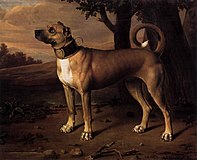 A "chamber dog" with a gilded collar, Brandenburg (Germany), 1705
A "chamber dog" with a gilded collar, Brandenburg (Germany), 1705
-
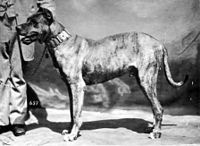 Great Dane from 1879
Great Dane from 1879
-
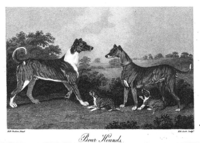 "Boar hounds" imported into Great Britain from the German Electorate of Hesse, 1807
"Boar hounds" imported into Great Britain from the German Electorate of Hesse, 1807
Description
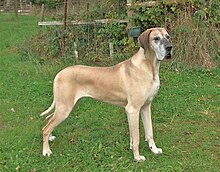
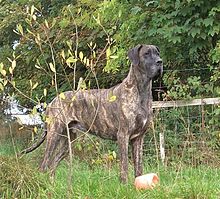
The Great Dane is an extremely large domestic dog of mastiff-sighthound type known for its big size. It is often dubbed the "Apollo of dogs".
As described by the American Kennel Club:
The Great Dane combines, in its regal appearance, strength, and elegance with great size and a powerful, well-formed, smoothly muscled body. It is one of the giant working breeds, but is unique in that its general conformation must be so well balanced that it never appears clumsy, and shall move with a long reach and powerful drive. The Great Dane is a short-haired breed with a strong, galloping figure.
In the ratio between length and height, the Great Dane should be square. The male dog should not be less than 30 in (76 cm) at the shoulders, a female 28 in (71 cm). Danes under minimum height are disqualified. Over the years, the tallest living dog has typically been a Great Dane. Previous record holders include Gibson, Titan, and George; however, the current record holder is a black Great Dane named Zeus that stood 111.8 cm (44.0 in) at the shoulder before his death in September 2014. He was also the tallest dog on record (according to Guinness World Records), beating the previous holder, the aforementioned George that stood 109.2 cm (43.0 in) at the shoulder.
The minimum weight for a Great Dane over 18 months of age, is 120 lb (54 kg) for males, 100 lb (45 kg) for females. Interestingly, the American Kennel Club dropped the minimum weight requirement from its standard. The male should appear more massive throughout than the female, with a larger frame and heavier bone.
Great Danes have naturally floppy, triangular ears. In the past, when Great Danes were commonly used to hunt boars, cropping of the ears was performed to make injuries to the dogs' ears less likely during hunts. Now that Danes are primarily companion animals, cropping is sometimes still done for traditional and cosmetic reasons. In the 1930s when Great Danes had their ears cropped, after the surgery, two devices called Easter bonnets were fitted to their ears to make them stand up. Today, the practice is still common in the United States, but much less common in Europe. In some European countries such as the United Kingdom, Ireland, Denmark, and Germany, and parts of Australia and New Zealand, the practice is banned or controlled to only be performed by veterinary surgeons.
Coat




According to the breed standard, Great Danes have six to seven (depending on the standard) show-acceptable coat colours:
- Fawn and brindle
- Fawn: The colour is yellow-gold with a black mask. Black should appear on the eye rims and eyebrows and may appear on the ears.
- Brindle: The colour is fawn and black in a chevron striped pattern. Often, they are also referred to as having a striped pattern.
- Black, harlequin and mantle
- Black: The colour is a glossy black. White markings on the chest and toes are not desirable and considered faults.
- Harlequin: The base colour is pure white with torn black patches irregularly distributed over the entire body; a pure white neck is preferred. The black patches should never be large enough to give the appearance of a blanket, nor so small as to give a stippled or dappled effect. Eligible, but less desirable, are a few small patches of grey that is consistent with a merle marking, or a white base with single black hairs showing through, which tend to give a salt and pepper or dirty effect. Merlequin (see below), a white coat with grey patches instead of black, is a disqualification.
- Grey merle (Grautiger) Great Danes are acceptable in conformation shows under the FCI. This color was previously a disqualifying fault, but the fault was deleted in a new breed standard in 2012 to provide a wider gene pool and because the grey merle gene can produce a correct harlequin coat. Their status is that they are "neither desirable nor to be disqualified". Consequently, this colour must never obtain the highest grading at dog shows.
- Mantle (in some countries referred to as Boston due to the similar colouration and pattern as a Boston Terrier): The colour is black and white with a solid black blanket extending over the body; black skull with white muzzle; white blaze is optional; whole white collar preferred; a white chest; white on part or whole of forelegs and hind legs; white tipped black tail. A small white marking in the black blanket is acceptable, as is a break in the white collar.
- Blue: The colour is a pure steel blue. White markings at the chest and feet are permitted - never with a fawn nuance or blackish-blue colour.
- Blue brindle: This is a brindle coat with a blue-gray background and darker brindle striping.
Temperament
The Great Dane's large and imposing appearance belies its outgoing and friendly nature that can make it a loving, devoted addition to any home. With proper supervision, they are known for seeking physical affection from their owners or non-owners that they know well. The breed is often referred to as a "gentle giant".
Great Danes are generally well disposed toward other dogs, other non-canine pets, and familiar humans. They generally do not exhibit extreme aggressiveness or a high prey drive. With proper care and training, they are great around children, especially when raised with them. However, if not properly socialized, a Great Dane may become fearful or aggressive towards new stimuli (such as strangers and new environments).
Health
Great Danes, like most giant dogs, have a fast metabolism. This results in more energy and food consumption per pound of dog than in small breeds. They have some health problems that are common to large breeds, including bloat (gastric dilatation volvulus).
Nutrition plays a role in this breed's health. Bloat, or gastric dilatation-volvulus (GDV), is the greatest killer of Great Danes. To avoid bloat, a rest period of 40 minutes to one hour after meals is recommended before exercise.
A 2024 UK study found the average life expectancy of the breed to be 10.6 years, compared to an average of 12.7 for purebreeds and 12 for crossbreeds.
Dilated cardiomyopathy and many congenital heart diseases are also commonly found in the Great Dane, leading to its nickname: the heartbreak breed, in conjunction with its shorter lifespan. Great Danes also may carry the merle gene, which is part of the genetic makeup that creates the harlequin coloring. The merle gene is an incomplete dominant, meaning only one copy of the gene is needed to show the merle coloring; two merle genes produce excessive white markings and many health issues such as deafness, blindness, or other debilitating ocular issues. Great Danes can also develop wobbler disease, a condition affecting the vertebral column. Since these dogs grow at a rapid rate, the bones in their vertebrae can push up against the spinal cord and cause weakness in the legs. This can be treated with surgery or may heal itself over time.
Like many larger breeds, Great Danes are at particular risk for hip dysplasia.
Cultural significance
| This section needs additional citations for verification. Please help improve this article by adding citations to reliable sources in this section. Unsourced material may be challenged and removed. (February 2015) (Learn how and when to remove this message) |
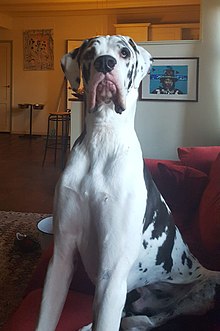
Animation
- Animation designer Iwao Takamoto based the character Scooby-Doo on a Great Dane. He derived his design from sketches given to him by a Hanna-Barbera employee who bred Danes, and then endeavoured to make Scooby the opposite of a perfect pedigree, with a longer tail, bowed legs, small chin and a sloping back.
Crime
- On 24 October 1975, Rinka, a Great Dane belonging to Norman Scott, was shot in a bungled attempt to murder Scott, in what became known as the Thorpe affair. In 1996, Scott Freeman and Barrie Penrose published Rinkagate: Rise and Fall of Jeremy Thorpe.
Mascots
- The Great Dane was named the state dog of Pennsylvania in 1965 and the University of Iowa had Great Danes, Rex I and Rex II, as mascots before the Hawkeye was chosen.
- "Great Danes" is the nickname of the University at Albany. Their mascot is the Great Dane.
Military
- Just Nuisance was the only dog to be officially enlisted in the Royal Navy. Done mainly as a morale booster for World War II enlisted troops, Nuisance proved to be a lasting legacy of the small Cape Town suburb of Simon's Town.
Philosophy
- An unnamed Great Dane knocks Jean-Jacques Rousseau to the ground in Reveries of a Solitary Walker; he describes the singular feeling of peace and suspended identity that the shock of the collision brings about in him.
See also
- Dogs portal
- List of dog breeds
- Reichshund, term used in Germany for Bismarck's Great Danes and, for a while, the entire breed
References
- Becker, Frederick (1905). The Great Dane: Embodying a Full Exposition of the History, Breeding Principles, Education, and Present State of the Breed. Read Books. ISBN 1-905124-85-6.
- "Great Dane Dog Breed Information". American Kennel Club. Retrieved 16 April 2022.
- Top 11 heaviest dog breeds
- Ludwig Beckmann (1895). Geschichte und Beschreibung der Rassen des Hundes, Volume 1, p. 6 (in German)
- The German standard term for "dog" is Hund; the term Dogge is only in use for dogs of the mastiff type.
- The French standard term for "dog" is chien; the term dogue is only used for dogs of the mastiff type.
- ^ Ludwig Beckmann. Geschichte und Beschreibung der Rassen des Hundes, Volume 1, 1895, p. 7 (German)
- Johann Täntzer. "Von den Englischen Hunden" . In Jagdbuch oder der Dianen hohe und niedrige Jagdgeheimnisse , Copenhagen, 1682 (in German): "Jetziger Zeit werden solche Hunde jung an Herrenhöfen erzogen, und gar nicht aus England geholet." English translation: "Today such dogs are bred at noblemen's courts, and not at all obtained from England." Cited in Ludwig Beckmann (1895). Geschichte und Beschreibung der Rassen des Hundes , Vol. 1, p. 7
- Johann Täntzer (1682). "Von den Englischen Hunden" . In Jagdbuch oder der Dianen hohe und niedrige Jagdgeheimnisse , Copenhagen. Cited in Ludwig Beckmann (1895). Geschichte und Beschreibung der Rassen des Hundes , Volume 1, 1895, p. 9
- Johann Friedrich von Flemming (1719). "Von denen Englischen Docken" . Der vollkommene teutsche Jäger . Leipzig. Volume 1, p. 169. Archived 6 October 2014 at the Wayback Machine. "... such a chamber-hound is mostly put about with a strong leather collar covered with green velvet, on which there are silver letters or the master's name or arms. ... Such body-dogs are also assigned beautiful collars of red or green plush with brass letters."
- "FCI Breed Standard Great Dane 2012" (PDF). Archived (PDF) from the original on 6 October 2014. Retrieved 15 January 2015.
- S. William Haas (2003). Great Dane: A Comprehensive Guide to Owning and Caring for Your Dog (Series: Comprehensive Owner's Guide), Kennel Club Books, 2003, p. 13
- Sève, Jacques de; Buvée; Lottré; Tardieu, Pierre François; Baquoy, Jean-Charles; Moitte, Pierre-Étienne; Leclerc, Georges-Louis (1755). "Le Grande Danois". Illustrations de Histoire naturelle générale et particulière avec la description du cabinet du roy (in French). Vol. 5. Paris: L'Imprimerie Royale. Pl. XXVI; p. 300. Archived from the original on 22 February 2015 – via Gallica.
- "Great Dane". Encyclopædia Britannica. 28 April 2023. Retrieved 15 June 2023.
- ^ "Great Dane Breed Standard". American Kennel Club. 1999. Archived from the original on 3 May 2005.
- Becker, The Great Dane – Embodying a Full Exposition of the History, Breeding Principles, Education, and Present State of the Breed (a Vintage Dog Books Breed Classic): Embodying a Full Exposition the History, Breeding Principles, Education, and Present State of the Breed Archived 27 May 2016 at the Wayback Machine, Published by READ BOOKS, 2005, ISBN 1-905124-43-0.
- ^ "The Home for Dog Owners and Those Working with Dogs: The Kennel Club". thekennelclub.org.uk. Archived from the original on 15 May 2007.
- ^ "Zeus, the world's tallest dog passes away at the age of 5". Guinness World Records. Archived from the original on 12 March 2016.
- "Giant George, Guinness World Record, Tallest Dog – giantgeorge". Archived from the original on 12 March 2016.
- "Dogs New Zealand -". www.nzkc.org.nz. Archived from the original on 28 June 2011. Retrieved 7 May 2018.
- Cunliffe, Juliette (2005). The Complete Encyclopedia of Dog Breeds. UK: Parragon Publishing. ISBN 1-4054-4389-8.
- "Popular Mechanics". Hearst Magazines. 5 December 1934. Archived from the original on 15 February 2022. Retrieved 27 October 2021 – via Google Books.
- FCI Breed Standard N° 235 Great Dane (Deutsche Dogge) Archived 6 October 2014 at the Wayback Machine (PDF)
- "Official Standard of the Great Dane" (PDF). American Kennel Club. 9 July 2018. Retrieved 11 March 2022.
- ^ Circular 67/2013 of the FCI, 23/12/2013 Archived 7 January 2014 at the Wayback Machine (PDF)
- "F.C.I. Standard N° 235, P. 7" (PDF). fci.be. Archived (PDF) from the original on 25 October 2017. Retrieved 7 May 2018.
- Tapio, Marjo (25 February 2019). "Great Dane Standard FCI" (PDF). www.fci.be. Archived (PDF) from the original on 6 October 2014. Retrieved 25 February 2019.
- MOIZ (12 September 2023). "The Majestic Blue Brindle Great Dane". Pet Reck. Retrieved 21 September 2023.
- Sam (26 December 2022). "All About Great Dane - Pet Paradise". Retrieved 26 December 2022.
- Ali, Sagheer (26 December 2022). "ALL ABOUT GREAT DANE". Pet Paradise.
- "Great Dane". Animal Planet. Archived from the original on 19 June 2012.
- Great Dane: A Comprehensive Guide to Owning and Caring for Your Dog, Kennel Club Book, 2003, ISBN 1-59378-273-X
- Biniok, Janice (10 August 2010). Great Dane: a practical guide for the Great Dane. Neptune City, NJ: T.F.H. Publications. ISBN 978-0-7938-4178-3.
- ^ "Great Dane Dog Breed Information". American Kennel Club. Archived from the original on 17 August 2012. Retrieved 18 February 2021.
- "Great Dane - Dogs 101 - Animal Planet". www.animalplanet.com. Archived from the original on 15 March 2018. Retrieved 7 May 2018.
- McMillan, Kirsten M.; Bielby, Jon; Williams, Carys L.; Upjohn, Melissa M.; Casey, Rachel A.; Christley, Robert M. (1 February 2024). "Longevity of companion dog breeds: those at risk from early death". Scientific Reports. 14 (1). Springer Science and Business Media LLC. doi:10.1038/s41598-023-50458-w. ISSN 2045-2322.
- McMillan, K. M.; Bielby, J.; Williams, C.L. (2024). "Longevity of companion dog breeds: those at risk from early death". Scientific Reports. 14: 531. doi:10.1038/s41598-023-50458-w. PMC 10834484.Supplementary Table 3
- "The Merle Gene and Multiple Ocular Abnormalities". Eye Care for Animals. Archived from the original on 12 December 2013.
- "World Small Animal Veterinary Association World Congress Proceedings, 2004". Vin.com. 30 March 2015.
- "Iwao Takamoto, 81, the Animation Artist Who Created Scooby-Doo, Dies" Archived 20 December 2016 at the Wayback Machine, by Susan Stewart, 10 January 2007, The New York Times
- "Iwao Takamoto, cartoonist who created Scooby-Doo, dies at 81" Archived 28 January 2007 at the Wayback Machine, The Associated Press, 9 January 2007, Canadian Broadcasting Corporation
- Ingham, Robert (1999). "The Jeremy Thorpe Story" (PDF). Journal of Liberal Democrat History. 23 (Summer): 22–23. Archived (PDF) from the original on 10 July 2018. Retrieved 1 June 2018.
- State Symbols USA Archived 9 April 2008 at the Wayback Machine, www.statesymbolsusa.org
- "Pop quiz: How well do you know the UI campus? - fyi — University Relations Publication — The University of Iowa". uiowa.edu. Archived from the original on 30 June 2013. Retrieved 3 May 2014.
- "Symbols of UAlbany". www.albany.edu. Archived from the original on 18 September 2015. Retrieved 2 December 2015.
- Rousseau, Jean-Jacques. Reveries of a Solitary Walker. Trans. Charles E. Butterworth. Indianapolis: Hackett Publishing (1992), pp. 15–18.
External links
- Giant George is the World's Biggest Dog
- The Great Dane Dog historical marker in Savannah, Georgia
| Dogs originating in Germany | |
|---|---|
| Hounds | |
| Gundogs | |
| Herding dogs | |
| Earth dogs | |
| Toy dogs | |
| Others | |
| Extinct | |